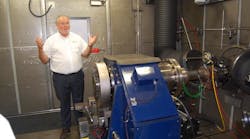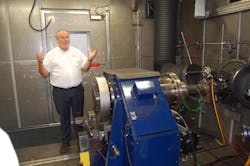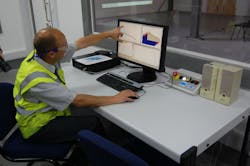I got a chance to tour Meritor’s research and development laboratory housed within its Cwmbran manufacturing plant in South Wales last week – a place where Knoop and his fellow engineers use all sorts of interesting machines to literally pummel and eventually destroy each and every brake product Meritor makes for the European commercial vehicle market.
For example, there’s a corrosion chamber that subjects brake components to extreme salt baths; a climate chamber that exposure them to constant high temperatures and humidity levels; a “slurry” chamber that recreates off-road conditions; plus a variety of “rigs” designed to generate a lifetime worth of physical stress in a matter of weeks.
[To view more photos click here and here.]
Then there are the dynamometers: big machines used to re-create what Knoop calls the “kinetic energy” of an entire truck. Residing within big steel containers, dynamometers are critical for engineers to develop a “bigger picture” about how brake and often entire axles behave under long-term dynamic loads – revealing critical durability and performance characteristics.“These are the first tests, where we learn if the designs we create on the computer can survive in the real world,” Knoop told me. “This is the starting point. If the design fails here, we go back and make changes. If it passes through these machines, we move on to the test truck stage.”
Noise analysis (being conducted in the photo above) is becoming an ever-more critical part of the testing process as well, he added, as trucking firms in particular seek to create better working conditions for their drivers. Thus NVH data collection – short for “noise, vibration, harmonics” – is now a regular part of Meritor’s component testing process at Cwmbran.
Tomorrow, I'll share some sights from the next testing stage familiar to every trucker: real-world field tests using actual commercial vehicles.





